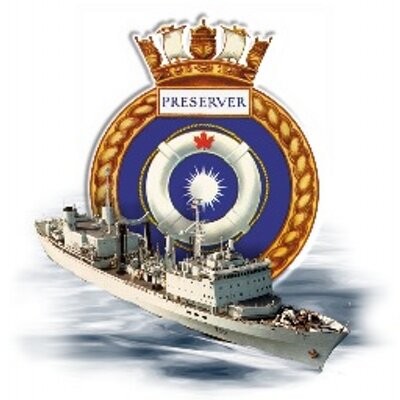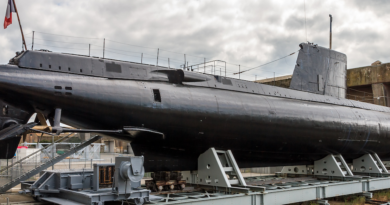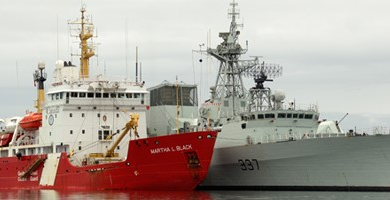Paying Off HMC Ships
On 21 October 2016, the Royal Canadian Navy (RCN) will ‘pay off2’ Her Majesty’s Canadian Ship (HMCS) Preserver. Her sister auxiliary oiler, Protecteur, and two destroyers, Iroquois and Algonquin, were paid off over the last two years as the RCN transitions to the Harry DeWolf-class patrol ships and other warships3 to be built. As ‘paying off’ may be unfamiliar to the general public, the following explanation is offered.
From Customs of the Navy, Lieutenant-Commander A.D. Taylor, RCN, 1961:
“Until 1825 pay was held back as a guarantee against desertion. It was the practice to pay off the men at the end of a commission, hence the expression, a ship paying off.”
‘Commission’ needs some explanation. An officer would receive orders from the Admiralty by which he would go aboard a ship where he would read his ‘commission’ to the ship’s company and thus bring the vessel into service as a warship of the monarch. The warship, having been fitted out and ready, would proceed on duty until, typically a few years later, the ship would return to a home port, the commission came to an end, and the men would be paid off and proceed to other work. The RCN until the mid-1960s and unification of the services into the Canadian Armed Forces (CAF) paid off ships into long refits and reserve. The modern RCN generally does not follow this practice but considers a warship in commission for the entire period she is in service, in Preserver’s case over 45 years. So, paying off is the term the RCN uses, and usually it occurs only once for a warship, when the service is finished with her. The term ‘decommissioning’ is in use by foreign navies such as the United States Navy and has a similar meaning, but should not be applied to Canadian warships.
Paid-off warships are usually put up for disposal. Disposal can include sale of the ships to be broken up or to be used for a purpose such as being sunk to become a breakwater or artificial reef. Protecteur and the destroyers are being broken up in Liverpool, Nova Scotia, an activity which is a boost to the local economy. Paid off ships may also go into reserve, though this has not been the case recently. Traditionally, ships between commissions were known as being ‘in ordinary,’ but that term can only be now used colloquially when referring to RCN warships. Older and unseaworthy ships with possibly some alongside use such as prison ship, were known as ‘hulks,’ not to be taken as a derogatory term but simply a status. The ex-RCN diving support vessel Cormorant, berthed at Bridgewater, is a hulk.
A paid-off ship is no longer in commission and no longer a warship. The ship’s name on the hull and the ship’s pendant number (also known as hull number because it is painted on the hull of the ship) are painted over. After paying off, it is incorrect to continue to use the HMCS part of the ship’s name. A paid-off ship, even when sold out of government service, may retain the main part of her name, but that is not to imply the government has any responsibility for her. Cormorant is an example of the main part of an ex-warship’s name still in use, as is Annapolis, recently sunk off Canada’s west coast to become an artificial reef. It is not incorrect to write ‘ex-HMCS Preserver; or ‘the former warship HMCS Preserver’ but those terms should be reserved for when the writer wishes to emphasize the ship’s past.
There is at least one aspect to paying off that can be confusing. A list of positions for a ship’s company, the unit ‘establishment,’ can be authorized prior to the commissioning of the ship, usually to gather the service members and prepare them to embark in their new ship. Also, the establishment extends for 30 days after the ship is paid off, after which the positions revert to central control. This extension is useful in that it allows the RCN to retain positions to make up the company of a soon-to-be-built ship (loss of positons after paying off is a reason the RCN ceased the practice of paying off ships into long refits in the mid-1960s). Despite being in a shore office and not in a ship, members of the ship’s company might at those times refer to their unit as HMCS Name. Administratively they are not wrong. Potentially confusing further, the Canadian Armed Forces uses an administrative term, ‘disbanding,’ for when a unit with its establishment is truly ended. The term is not inappropriate for its feel of shipmates departing each other.
As then paying off usually occurs but once in a modern Canadian warship’s life, there is a lot of ceremony involved. One part is the flying of a paying off pennant by the ship upon her latest sailing into harbour. Again, from Customs of the Navy:
“The paying-off pendant (sic) dates from the 19th century when cleaning rags in a ship decommissioning were knotted together and hoisted as a sign that they would no longer be used. For uniformity (?) the practice is for the pendant to be the length of the ship if she paid off on the proper date, with the addition of 1/24th of the length for each additional month. Some sources say 1/12th, but as foreign commissions in the RN until recently have been reckoned as being of two years’ duration 1/24th may be correct. Still another version holds the custom more simply as a foot for each month in commission.”
From the Royal Navy’s Admiralty Manual of Seamanship 1979 (HMSO), Volume 1:
“Since before the Napoleonic wars it was the custom of HM ships to fly a paying-off pennant at the main truck when they left their fleet to return to their home port to pay off. Custom ordained that the length of the pennant should equal the length of the ship if she left station at the end of a normal period of foreign service. If, however, a commission had been extended, the length of the pennant was increased in proportion to the extra length of service (e.g. for a commission of 2 years extended to 2 years and 2 months the length of the pennant would be the length of the ship plus 1/12th). It was similar to, and flown in place of, the masthead pennant, and was displayed by a ship from a foreign station when entering or leaving harbours during her passage home, and by a ship of the fleet on leaving for and arriving at her home port. It was also the custom on all stations for a ship to fly this pennant on the Sunday preceding her departure, or, if already in her paying-off port, on the Sunday preceding the day on which she paid off.”
The RCN’s Manual of Ceremony for HMC Ships, Submarines and Naval Reserve Divisions has some information about paying off pennants, and it is understood the next edition will address the entire subject in greater detail. From the manual:
“Paying Off Pennant
(1) The Paying Off Pennant is flown when a ship departs her group and enters her home port for the last time.
(2) For HMC Ships, Paying Off Pennants are based on the Commissioning Pennant and are of a uniform length of 85.5 metres regardless of the period of commission.
Standard lengths were directed in the 1960s to end the practice of ridiculously long paying off pennants, in the case of HMCS Sioux, 2500 feet. Preserver’s pennant is 380 feet (116 metres) long, appropriate what with her size compared to destroyers and frigates for whom a smaller pennant would be a better fit.
Customs and traditions are essential to a service, especially to provide a unifying element to the understanding and language of its members. Knowledge of those customs and traditions is also useful to those not of the service but have some link with it, whether it be as writers or potential supporters, in order that they may understand the people and activities of the service. It is incumbent on all to have a reasonable familiarity of the practices of the service, and to use the right language.
Notes:
- This is an update of the original published 10 April 2015.
- The Chief of Defence Staff of the Canadian Armed Forces is the authority who orders a ship to pay off.
- Warship “means a ship belonging to the armed forces of a State bearing the external marks distinguishing the character and nationality of such a ship, under the command of an officer duly commissioned by the government of that State and whose name appears in the appropriate service list or its equivalent, and manned by a crew which is under regular armed forces discipline;” San Remo Manual on International Law Applicable to Armed Conflicts at Sea, Sec. V para. 13(g) (https://www.icrc.org/eng/resources/documents/misc/57jmsu.htm) accessed 9 April 2015
Recommended citation: Colin Darlington, Paying Off HMC Ships, Royal United Services Institute of Nova Scotia, October 14, 20161



